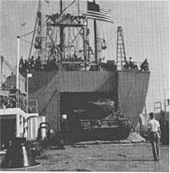Vehicle landing ship
Vehicle landing ships ( Landing Ship, Vehicle - LSV ), later called Vehicle Cargo Ship (also called LSV), emerged during World War II in the USA as amphibious transporters based on the principle of the RoRo ship .
history
On April 21, 1944, two Catskill-class minerships and four Osage-class net layers were designated as vehicle landing ships for the Pacific theater of war and converted accordingly. The floating vehicles on board ( DUKW and landing craft of the types LCVP and LVT ) were able to leave the LSV via the stern and side gates before reaching the coast. The first LSV could take up to 21 lightly armored tracked vehicles and up to 31 army tractors or trucks, some even a further 14 vehicle landing craft, and between 868 and 1,358 troops.
With a displacement of 4,626 to 5,875 tons, they could run at a speed of 21 knots. They were armed with two 5-inch cannons in single mounts, four 40-mm twin flak and twenty 20-mm rapid-fire cannons. After the end of the Second World War, the LSV were converted into mine vehicles between June 1946 and May 1947 and added to the reserve fleet, but some were used again in the Vietnam War .
In January 1963, in a second attempt, T-LSV from existing ships were retrofitted, which could also be loaded and unloaded according to the principle of the RoRo ship, but required port facilities (piers) for this. Accordingly, despite the identifier T-LSV, they were not referred to as vehicle landing ships, but as vehicle transport ships, as indicated by the T in the identifier. The T in the identifier also indicates ships with civilian crews under the direction of the Maritime Transport Command (MSC = Military Sealift Command or previously MSTS = Military Sea Transportation Service). In 1968 the identification LSV was given up in favor of AKR (A = Auxiliary = aid ship).
Vehicle landing craft
- LSV-1 Catskill later MCS-1
- LSV-2 Ozark later MCS-2
- LSV-3 Osage later MCS-3
- LSV-4 Saugus later MCS-4
- LSV-5 monitor later MCS-5
- LSV-6 Montauk renamed Galilea (AKN-6)
- T-LSV-7 Comet ex T-AK-269, later T-AKR-7
- T-LSV-8 Taurus ex T-AK-273
- T-LSV-9 Sea Lift renamed Meteor (T-AKR-9)
swell
- Jürgen Gebauer, Egon Krenz: Marine Encyclopedia , Vienna 2003.
- Jürgen Döscher, short list of the categories from 1920–2000, Hagen 2001 (not published)


